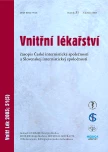Our experience in the treatment of membranous nephropathy with cyclosporine
Authors:
M. Janeček; Z. Říhová; V. Tesař; M. Merta; D. Kmentová
Authors‘ workplace:
Klinika nefrologie 1. lékařské fakulty UK a VFN, Praha, přednosta prof. MUDr. Vladimír Tesař, DrSc.
Published in:
Vnitř Lék 2005; 51(5): 504-509
Category:
Original Contributions
Overview
In a group of 17 patients with primary membranous glomerulonephritis, we assessed the impact of cyclosporine therapy on proteinuria and glomerular filtration. The indications for treatment with cyclosporine were: nephrotic syndrome resistant to chlorambucil (10 patients), cyclophosphamide (2 patients) or cyclophosphamide and chlorambucil (1 patient). We also treated with cyclosporine 3 patients with a high risk of thromboembolic complications (proteinuria above 10 g/24 hours) and one young patient was treated with cyclosporine at a dose not exceeding the gonadotoxic dose of cyclophosphamide. Treatment was started at a dose of 5 mg/kg/day and adjustments in dosages were made to achieve a trough plasma level of cyclosporine between 80–120 ng/ml, as measured by High Performance Liquid Chromatography. Simultaneously, we administered corticosteroids in a daily dose of 20 mg of prednisone or less. We followed the levels of proteinuria, serum creatinine and creatinine clearance before the treatment with cyclosporine, after one year of treatment, and at one and two years after withdrawal of cyclosporine. After one year of therapy, we observed a decline in proteinuria from 10.5 (3.1–35) to 1.7 (0.22–17.4) g/24 hours [median (range)]. This was a statistically significant decline remaining one and two years after stopping cyclosporine (Wilcoxon’s paired test p < 0.01). The decline in proteinuria, after either one year of treatment and at one year after stopping treatment, was also significant in the subset of patients with membranous nephropathy refractory to chlorambucil. Our evaluation of changes in glomerular filtration using the reciprocal value of serum creatinine revealed a possible transient decline in renal function after one year of cyclosporine therapy, but we did not observe a corresponding change in creatinine clearance. Our experience confirms the importance of cyclosporine in the treatment of membranous nephropathy and shows the effectiveness of this drug even in cases refractory to prior treatment with chlorambucil.
Key words:
cyclosporine – membranous nephropathy – glomerulonephritis
Sources
1. Cattran DC, Appel GB, Hebert LA et al. Cyklosporin in patients with steroidresistant membranous nephropathy: A randomized trial. Kidney Int 2001; 59 : 1484–1490.
2. Cattran DC, Greenwood C, Ritchie S et al. A controlled trial of cyclosporine in patients with progressive membranous nephropathy. Kidney Int 1995; 47 : 1130–1135.
3. Cattran DC, Pei Y, Greenwood CMT et al. Validation of a predictive model of idiopathic membranous nephropathy: Its clinical and research implications. Kidney Int 1997; 51 : 901–907.
4. Fritsche L, Budde K, Färber L et al. Treatment of membranous glomerulopathy with cyclosporin A: how much patience is required? Nephrol Dial Transplant 1999; 14 : 1036–1038.
5. Muirhead N. Management of idiopathic membranous nephropathy. Evidence–based recommendations. Kidney Int 1999; 70(Suppl): S47–S55.
6. Pei Y, Cattran D, Greenwood C. Predicting chronic renal insufficiency in idiopathic membranous glomerulonephritis. Kidney Int 1997; 51 : 901–907.
7. Polenakovic MH, Grcevska L. Treatment and Long Term Follow-Up of Patients With Stage II to III Idiopathic Membranous Nephropathy. Am J Kidney Dis 1999; 34 : 911–917.
8. Ponticelli C, Zucchelli P, Passerini P et al. Methylprednisolone plus chlorambucil as compared with methylprednisolone alone for the treatment of idiopathic membranous nephropathy. N Engl J Med 1992; 327 : 599–603.
9. Rostoker G, Belghiti D, Maadi A et al. Long-Term Cyclosporin A Therapy for Severe Idiopathic Membranous Nephropathy. Nephron 1993; 63 : 335–341.
10. Schück O, Tesař V, Teplan V et al. Klinická nefrologie. Praha: Medprint 1995.
11. Teplan V. Měření glomerulární filtrace – komentář. Medicína po promoci 2002; 3 : 46–49.
12. Zvárová J. Základy statistiky pro biomedicínské obory. Praha: Karolinum 1998.
Labels
Diabetology Endocrinology Internal medicineArticle was published in
Internal Medicine

2005 Issue 5
Most read in this issue
- Acute myocarditis, prevalence, diagnosis and treatment in local hospital
- Vasospastic angina pectoris – pathogenesis, diagnostics and treatment
- Our experience in the treatment of membranous nephropathy with cyclosporine
- Pneumology problems of patients with diabetes mellitus
